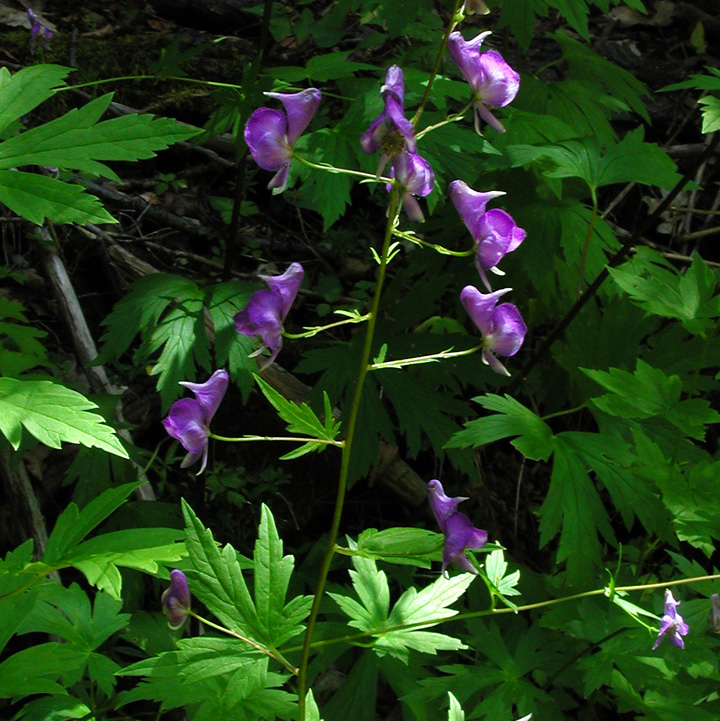- Home
- Search
- Images
- Datasets
- Sample Use
- How to Cite
- Additional Information
- About NEON
- NEON Data Portal
- ASU Biocollections
- About Symbiota
|
Family: Ranunculaceae |
Herbs , perennial, from tubers or elongate, fascicled roots. Leaves basal and cauline, proximal leaves petiolate, distal leaves sessile or nearly so; cauline leaves alternate. Leaf blade palmately divided into 3-7 segments, ultimate segments narrowly elliptic or lanceolate to linear, margins incised and toothed. Inflorescences terminal, sometimes also axillary, 1-32(-more) racemes or panicles, to 28 cm; bracts leaflike, not forming involucre. Flowers bisexual, bilaterally symmetric; sepals not persistent in fruit; lower sepals (pendents) 2, plane, 6-20 mm; lateral sepals 2, round-reniform; upper sepal (hood) 1, saccate, arched, crescent-shaped or hemispheric to rounded-conic or tall and cylindric, usually beaked, 10-50 mm; petals 2, distinct, bearing near apex a capitate to coiled spur, concealed in hood, long-clawed; nectary present, on spur; stamens 25-50; filaments with base expanded; staminodes absent between stamens and pistils; pistils 3(-5), simple; ovules 10-20 per pistil; style present. Fruits follicles, aggregate, sessile, oblong, sides prominently transversely veined; beak terminal, straight, 2-3 mm. Seeds deltoid, usually with small, transverse, membranous lamellae. x =8. The greatest concentration of species of Aconitum is in Asia, with a smaller group in Europe. Aconitum is phylogenetically most closely related to Delphinium Linnaeus as evidenced by similarities in karyotype, production of diterpene alkaloids, and similarities in floral morphology. Distinctive and unique floral morphology clearly distinguishes Aconitum from all other genera. The aconites have been of interest since ancient times because they contain diterpene alkaloids that range from relatively nontoxic to deadly poisonous. In various parts of the world they have been used medicinally and as a source of poisons throughout history (D. E. Brink 1982). Use of Aconitum alkaloids in modern medicine was largely discontinued by the late 1930s and early 1940s (E. E. Swanson et al. 1938; H. C. Wood and A. Osol 1943; A. Osol et al. 1960). Aconitum is a circumboreal arctic and alpine genus that extends into lower latitudes where there is suitable mesic habitat at high elevations along the north-south chains of mountains in eastern and western North America, and also in outlying, scattered, mesic, interglacial refugia, occasionally at low elevations. The genus Aconitum worldwide is notorious for complex patterns of morphologic intergradation that blur the lines between taxa. Aconites from different regions may be morphologically distinct but connected by a series of intermediate races. Aconitum columbianum exemplifies this in North America, and A . delphiniifolium may extend this complex of variation into Asia. Intergradation between A . columbianum and A . delphiniifolium should be more fully investigated. Cultivated aconites with origins outside North America sometimes persist in old gardens or are encountered as garden escapes, especially in eastern Canada (New Brunswick, Newfoundland, Nova Scotia, Ontario, and Quebec). These may include Aconitum lycoctonum Linnaeus, A . napellus Linnaeus, A . variegatum Linnaeus, and A . bicolor Schultes. Aconitum lycoctonum is similar to A . reclinatum of the southeastern United States in having the tall, conic-cylindric hood that is characterisitc of species in Aconitum sect. Lycoctonum de Candolle. Aconitum reclinatum has white flowers whereas A . lycoctonum has lilac-purple flowers. Aconitum napellus and A . variegatum are European introductions with leaves divided to the base as in A . delphiniifolium , which is native to Canada and Alaska. The introduced species have taller hoods and relatively short-petiolate leaves compared to A . delphiniifolium ; in A . delphiniifolium petioles are longer, i.e., mostl Fls irregular; calyx corolloid, with unequal sep, the upper one (called the helmet) the largest, strongly arched or hooded, its tip prolonged forward and downward into a short beak; upper 2 pet concealed under the helmet, clawed, nectariferous at the tip; lower 3 pet vestigial or wanting; stamens numerous; pistils 3-5, the fr follicular; poisonous perennial herbs with broad, palmately cleft lvs and showy, mostly blue or white fls in a terminal raceme or panicle. 50+, Eurasia and N. Amer. Gleason, Henry A. & Cronquist, Arthur J. 1991. Manual of vascular plants of northeastern United States and adjacent Canada. lxxv + 910 pp. ©The New York Botanical Garden. All rights reserved. Used by permission. |


